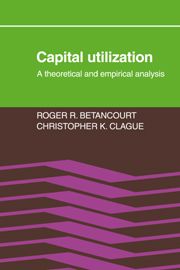Book contents
- Frontmatter
- Contents
- List of tables and figures
- List of propositions
- Preface
- Glossary of symbols
- Introduction
- 0 A preliminary view of capital utilization
- Part I Shift-work and the theory of the firm
- Part II Estimation
- Part III Results
- Part IV Implications
- 9 Analysis of policy changes
- 10 Capital utilization and economic growth
- 11 Shift-work and the dual economy
- 12 Conclusions and speculations
- References
- Index
12 - Conclusions and speculations
Published online by Cambridge University Press: 05 March 2012
- Frontmatter
- Contents
- List of tables and figures
- List of propositions
- Preface
- Glossary of symbols
- Introduction
- 0 A preliminary view of capital utilization
- Part I Shift-work and the theory of the firm
- Part II Estimation
- Part III Results
- Part IV Implications
- 9 Analysis of policy changes
- 10 Capital utilization and economic growth
- 11 Shift-work and the dual economy
- 12 Conclusions and speculations
- References
- Index
Summary
Our first task in this final chapter is to summarize the main conclusions of Chapters 1 through 11. This task will occupy us in Section 12.1. Then in Sections 12.2 and 12.3 we shall discuss, in a tone more subjective and speculative than in the rest of the book, the human costs of shift-work and the public-policy issues raised by our general subject.
Summary of findings and conclusions
The conclusions will be listed under the headings of methodological issues, substantive findings on the determinants of shift-work, and the productive and distributive effects of shift-work. With the exception of statements 3, 4, 10, and 17, which apply to shift-work exclusively, all of the following conclusions are applicable to both shift-work and capital utilization.
Methodological issues
1. According to economic theory, shift-work is both cause and consequence of capital intensity. On the consequence side, this statement has been part of conventional wisdom for a long time; the causal aspect was pointed out first by Marris (1964). The following implication of the statement, however, has not been widely appreciated: Observed correlations between capital intensity and shift-work do not provide empirical confirmation that capital intensity is a cause of shift-work.
2. Shift-work may be both cause and consequence of scale. Shift-work is always a cause of large scale in the sense that the undertaking of shift-work causes total factory output to be larger than it would otherwise be.
- Type
- Chapter
- Information
- Capital UtilizationA Theoretical and Empirical Analysis, pp. 216 - 233Publisher: Cambridge University PressPrint publication year: 1981



